Have you ever stood in your yard looking at the property line and thought about how to make it the perfect backdrop for your garden and outdoor living area? If so, then we have the perfect guide for you! Property Line Landscaping Ideas provides full information, useful tips, and creative ideas to help you craft a one-of-a-kind look that both enhances your home’s exterior atmosphere and defines its unique boundaries. So get ready to start planning your landscaping project and create a dreamy outdoor experience.
Steps to Take Before Landscaping the Edge of Your Property
Before you start landscaping the edge of your property, there are a few important steps to take to ensure that you create a beautiful and functional landscape.
- Determine who owns the property line and get permission if necessary: It’s important to know exactly where your property lines lie so that no fencing or landscaping is done on someone else’s land. Make sure to check with an inspector or surveyor if needed.
- Check local zoning regulations: Many communities have specific rules about how close fences can be built to the street, how high they can be, etc., so it’s important to familiarize yourself with these regulations before starting any project.
- Decide what type of landscaping you want to do: Do you want to go for a natural look with lots of plants and trees, or are you looking for something more formal with lots of hardscaping? This will help determine the types of materials and tools you’ll need.
- Consider your budget: Landscaping can be expensive, so it’s important to consider how much money you have available for the project. Don’t forget that there may be additional costs such as permits, professional services, and maintenance.

Once these steps have been completed, you’re ready to start exploring property line landscaping ideas!
Ideas for Landscaping Property Lines
Property line landscaping can add charm and beauty to your property, while also providing you with much-needed privacy. Whether you’re looking for an easy way to spruce up your landscape or want to create a more customized look, there are many options available. In this guide, we’ll provide you with some ideas for landscaping property lines that will help make your outdoor space look great.
One of the most popular types of property line landscaping is the use of shrubs and trees. Not only do these plants give you instant privacy from neighbors or passersby, but they also provide shelter and shade in the hot summer months. A few evergreen trees are a great choice for year-round color and coverage.
These will give you beautiful foliage in the fall and winter months.Another option for property line landscaping is to create a border around your property. This can be done with bricks, stones, wood chips, or even metal edging. The first two choices are great if you want a softer look; while the latter two materials give a more modern vibe. You can also choose from traditional straight lines or use curved designs for added interest.
If you want to add some extra color and interest to your property line landscaping, consider using annuals and perennials along your borders or beds. Planting several species of flowers will provide year-round color and a beautiful backdrop for your outdoor space. A few climbing vines along the property line can also provide a natural fence or wall that adds privacy without making it feel too closed in.
Finally, be sure to consider adding some hardscape elements to your landscape. This could include pathways, patios, arbors, and more. These features will not only add charm and character to your property lines but can also increase their value and create extra usable space as well.
Regardless of which type of landscaping you choose for your property line, it’s important to plan ahead and make sure that everything is set up properly. Taking the time to create a cohesive design will ensure that you get the most out of your landscaping project. With the right materials and a bit of creativity, you can create an outdoor space that is both beautiful and practical.
Keep in mind, it’s also important to consider any local ordinances or regulations when landscaping your property lines. It’s best to check with your local government or homeowners’ association before beginning any project so that you stay on the right side of the law. Once you have all the necessary details worked out, you can start planning and designing your perfect landscape!
Green or Colorful Evergreen Shrubs
Green or colorful evergreen shrubs are a great way to separate your yard from that of your neighbors. The best way to achieve this is by planting a living fence! Evergreen shrubbery creates a neat and tidy border for the property line, keeping things nice and defined. They also provide privacy and protection from wind and snow. Keep in mind though, if you plan on having any sort of view across the property line, it may be blocked off by an evergreen wall.

If you’re looking for something more decorative than just plain green bushes, try adding some colorful varieties like azaleas or rhododendrons. These plants will add a pop of color throughout the year. Plus, they’ll help attract birds, butterflies and other wildlife to your yard.
When deciding on evergreen shrubs for the property line, make sure to choose plants that are suited to your climate. Also, keep in mind that some species can get quite large over time, so be prepared to trim them back or even replace them if needed! Last but not least, always research how deep you need to dig when planting along a property line as this will depend on local regulations.
Mixing Evergreen and Flowering Shrubs
Evergreen shrubs look great all year round, and mixing them with flowering shrubs can add a lot of depth and interest to your property line landscaping. Some popular evergreen shrubs for boundary lines are boxwood, rhododendrons, yews and junipers. These will provide a nice backdrop for the flowers you choose to plant along the boundaries. Bright-colored spring blooms such as tulips, lilies or roses are especially attractive beside an evergreen hedge. You could also use colorful annuals like petunias or marigolds for seasonal pops of color throughout the year. For added texture, consider adding other plants such as ornamental grasses or vines to give your property line some extra flair. With careful planning and a few simple additions, you can turn your property lines into a stunning feature that will be admired by all.
Tall Ornamental Grasses in Borders
Tall ornamental grasses are a stylish way to create a sense of privacy and enclosure along property lines. These grasses can reach three or four feet in height, providing an effective visual barrier between two yards. Planting them in clusters at the far end of the border helps draw the eye away from any hardscape elements like fence posts or walls. With their graceful movement and lush foliage, tall ornamental grasses also add vibrant texture and color to your landscape design. There are many varieties to choose from; for example, feather reedgrass, fountain grass, purple moor grass, giant miscanthus, and tufted hairgrass all make great selections for property line borders. To keep them looking their best and prevent overcrowding, be sure to trim the grasses back in late winter or early spring.
Holly Shrubs to Deter Trespassers
Holly shrubs are a popular choice for property line landscaping. This type of evergreen is known to deter trespassing because the thick and thorny foliage makes it difficult for trespassers to access your yard. Holly shrubs can also provide privacy and security, as they’re not easy for intruders to get through.

Additionally, these plants can add beauty to your landscape with various shapes, sizes, and colors that range from deep green hues to bright red berries. Make sure you plant the hollies at least five feet away from the property line so that you won’t have to worry about them spilling over onto neighboring yards. Finally, make sure you’re aware of their growth rate; some holly shrubs can get quite large over time.
Hedges for Natural Fences
Hedges are an excellent choice for property line landscaping. They can provide a natural barrier between your home and the neighboring lot without looking too harsh or imposing. You can choose from evergreen varieties such as boxwood, juniper, yew, holly, or privet to create a lush wall of greenery. Or you can go with deciduous plants like viburnum, hawthorn, beech, and hornbeam that will provide seasonal changes in foliage color and texture. To maximize privacy while still maintaining an open feel, consider planting several staggered rows of hedges at varying heights. And don’t forget about pruning! The more frequently you trim your hedges, the fuller they’ll look over time.
Evergreen Trees for Windbreaks
Planting evergreen trees to form a windbreak is an excellent landscaping idea for those who live in areas with harsher climates. Evergreens are the perfect choice for property line landscaping because they can be planted in rows, providing protection from strong winds while also adding beauty and color to your landscape. To make sure you get the most out of your windbreaks, consult with a landscaping expert or horticulturist to find out which species are best suited to your region’s climate and soil type. Plus, keep in mind that evergreens will need regular trimming and pruning so they don’t become overgrown. With proper care, these trees can provide long-lasting protection and beauty to your property line spaces! [1]
Mix-and-Match
When it comes to landscaping along your property line, there are many design possibilities. To get the most out of your space, you can mix and match different elements to create an attractive and inviting yard.
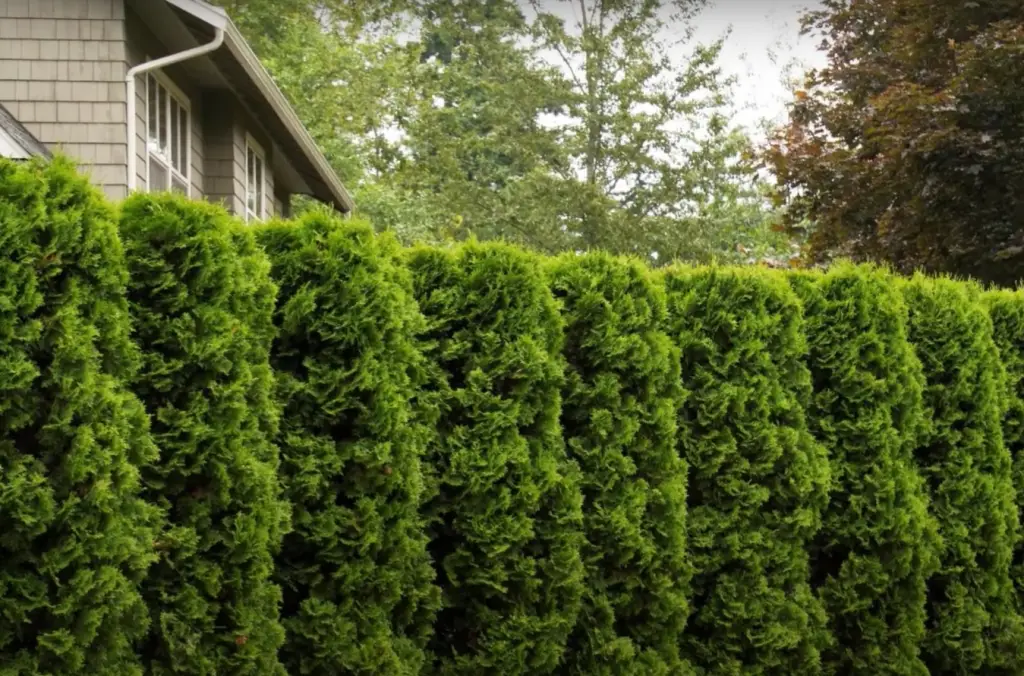
Here are some ideas that you can try in your backyard:
- Create a garden bed filled with colorful perennials and shrubs. This will brighten up the area while keeping maintenance low.
- Add a few large trees or evergreens for privacy as well as visual interest. These also provide shade from the sun during hot summer days.
- If you need more privacy, use fencing made of wood, wrought iron, bamboo, or other materials to separate your lawn from your neighbors.
- Add a few decorative items such as birdbaths, fountains, statues, or garden art to make your yard look even more appealing.
- Put in a small patio area with chairs and tables for outdoor entertaining. This will give you a great spot for relaxing with friends and family or grilling dinner during summer evenings.
- Install some landscape lighting for safety and ambiance at night. You can opt for low voltage LED lights or solar powered lights to save on energy costs.
By combining all of these elements, you can create an attractive, inviting space along your property line that is both functional and aesthetically pleasing. With just a bit of planning and creativity, you can transform your backyard into your own outdoor oasis!
We hope that these property line landscaping ideas help to inspire you in creating the perfect outdoor space. With a bit of effort and some imagination, you can create a beautiful yard that you and your family will enjoy for years to come.
Windbreaks & Pollution
Windbreaks are a great way to reduce wind speeds and create a pleasant environment. Pollution barriers can also help reduce noise, dust, and other airborne pollutants by creating physical obstructions. Both of these solutions are perfect if you’re looking for property line landscaping ideas that offer benefits beyond the aesthetic.
When deciding on the type of plants to use in your windbreak or pollution barrier, be sure to choose ones that will thrive in your climate and soil conditions. For example, evergreens such as arborvitae and cypress trees are good choices for temperate climates where cold winters occur, while deciduous trees such as maples and oaks work better in more mild climates. Additionally, tall grasses or shrubs like Juniper can help block out wind and unwanted noise.
If building a tall wall isn’t an option, consider using low-growing groundcover plants such as ornamental grasses or creeping junipers to create a living barrier. Just be sure to avoid invasive species!
Finally, don’t forget that the more layers you add, the better your protection will be against wind and pollution. Consider adding in walls of evergreen trees, then layering them with smaller shrubs and other foliage for extra density. This technique is especially effective if you’re trying to create sound barriers between two properties.
Stone Walled
Creating a stone wall is one of the most popular property line landscaping ideas. It can be used to define property lines or just enhance the look of your yard. You can choose from various types of stones, such as brick, flagstone, and even concrete blocks.
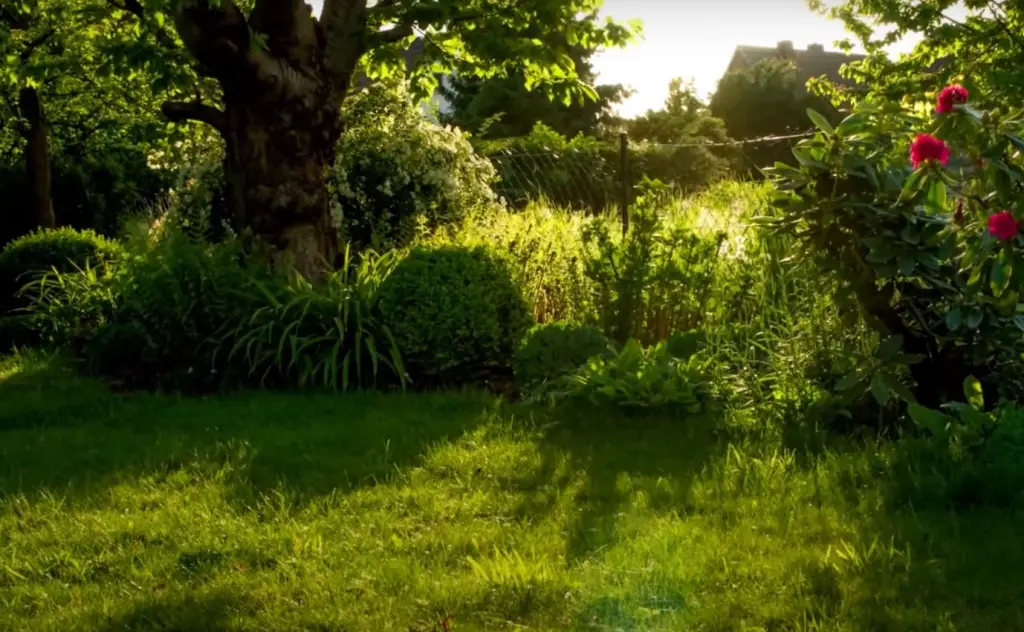
Creating a stone wall involves careful planning and measurement in order to ensure that it will be level and have proper drainage. When creating a stone wall along your property line, you should also make sure it’s high enough not to impede visibility for other people who might be using the area. Stone walls are also great for defining areas within your own yard such as garden beds or separate spaces for entertaining guests. [2]
Wooden fencing
Wooden fencing is one of the more popular choices for property line landscaping ideas. It provides a classic and elegant look to your landscape, while also providing privacy and security. When selecting a wooden fence, you should consider the style that fits with your home’s architecture as well as its durability.
You will also want to make sure that you select the right height for your fence to ensure that it meets local regulations and restrictions on fence heights in your area. With the right materials and design, a wooden fence can be an attractive addition to any landscape!Chain-link fencing
Chain-link fencing is a great way to define the boundaries of your property and can be used for both decorative and practical purposes. Chain-link fencing comes in different sizes, heights, colors, and styles so you can find something that fits into your landscaping design. When it comes to maintenance, chain-link fences are relatively easy to maintain since they don’t require regular painting or staining like other types of fences. It’s also important to make sure there are no sharp edges on any part of the fence as these can be dangerous if not properly maintained. Additionally, you should use an anti-rust treatment every few years to ensure that your fence will last longer and remain to look its best. With proper care and maintenance, a chain-link fence can provide your property with an attractive and secure border for many years to come.
Vegetable garden
If you have a property line that gets plenty of sunshine, consider planting a vegetable garden. This can be an enjoyable and rewarding way to spruce up your landscape while growing delicious produce for your table. You’ll need to make sure you choose vegetables that will thrive in the sunlight, soil quality and climate of your area. Additionally, it is important to pick vegetables with similar growth cycles so you are able to easily harvest them all at once without having to manage different crop rotations throughout the season.
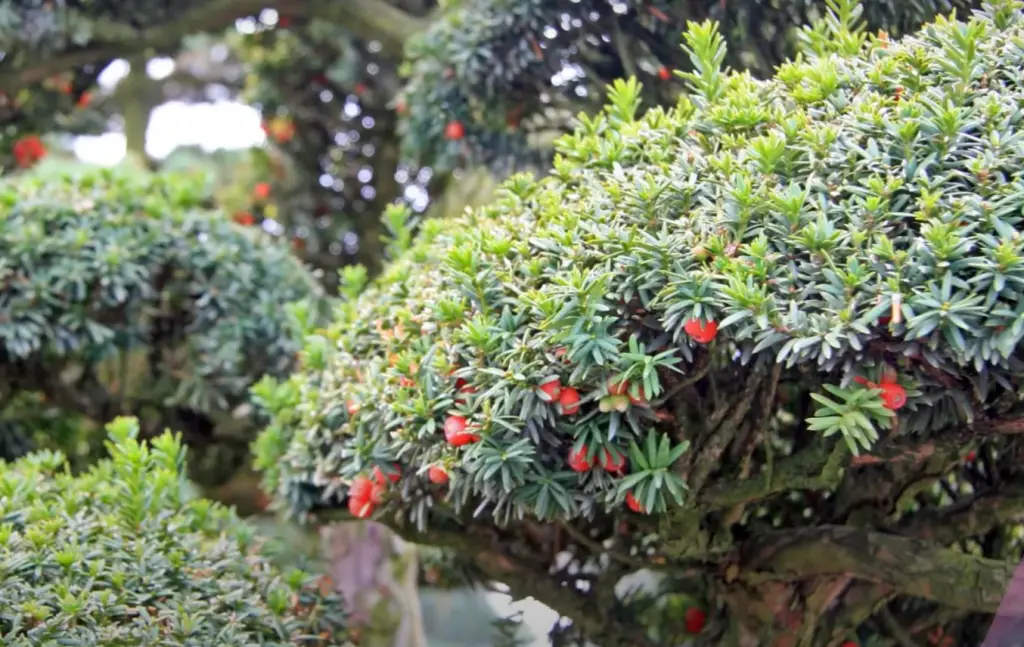
After you have planted your seeds or seedlings, maintain the garden by weeding regularly, watering timely and adding compost as needed. With some regular care, you’ll find yourself harvesting healthy vegetables in no time!
Flower garden
One of the best property line landscaping ideas is to create a flower garden. This can be done by planting flowers along your property line near the fence or wall. You can choose from annuals, perennials, and biennials for your flower garden which will bring bursts of color every year. Some great choices include roses, daisies, dahlias, sunflowers, and peonies. To make sure your flowers thrive, make sure you water them regularly and fertilize them during the growing season. Additionally, it’s important to select plants that are compatible with each other and suited to your climate so they don’t die off quickly. Lastly, weed control is key so ensure you keep up with this task. A flower garden is a great way to show off your property line while providing a burst of color and life!
A path or driveway
A path or driveway is an ideal way to separate your property from the one next door. Not only does it do this aesthetically, but it also serves as a physical barrier between yours and their land. If you are feeling creative, you can even use different materials for each side of the path or driveway to create a unique look.
You can choose from a variety of materials, such as gravel, pavers, brick, concrete, or even wood chips. Depending on the style of landscaping that you want to achieve and how much maintenance you would like to do on the driveway will determine which material is best for you.
No matter which material is chosen, make sure that there is enough space in between your property and the neighbors for any vehicles that may pass through. Also, make sure that all of the materials are durable enough to withstand changing weather conditions.
If you want to enhance your path or driveway, consider adding a border. You can use stones, bricks, plants, or even railroad ties. This will add an extra layer of style and definition to your property line landscaping project! Lastly, don’t forget about lighting options for both security and aesthetic purposes when walking along the path at night.
Ornamental grasses
Ornamental grasses are a great choice for property line landscaping. They offer low maintenance, hassle-free beauty that’s easy to incorporate into your design. From tall, billowing varieties like pampas grass to shorter, more compact types like tufted hairgrass, they come in all shapes and sizes. Plus, they’re very drought tolerant so you won’t have to worry about watering them regularly.
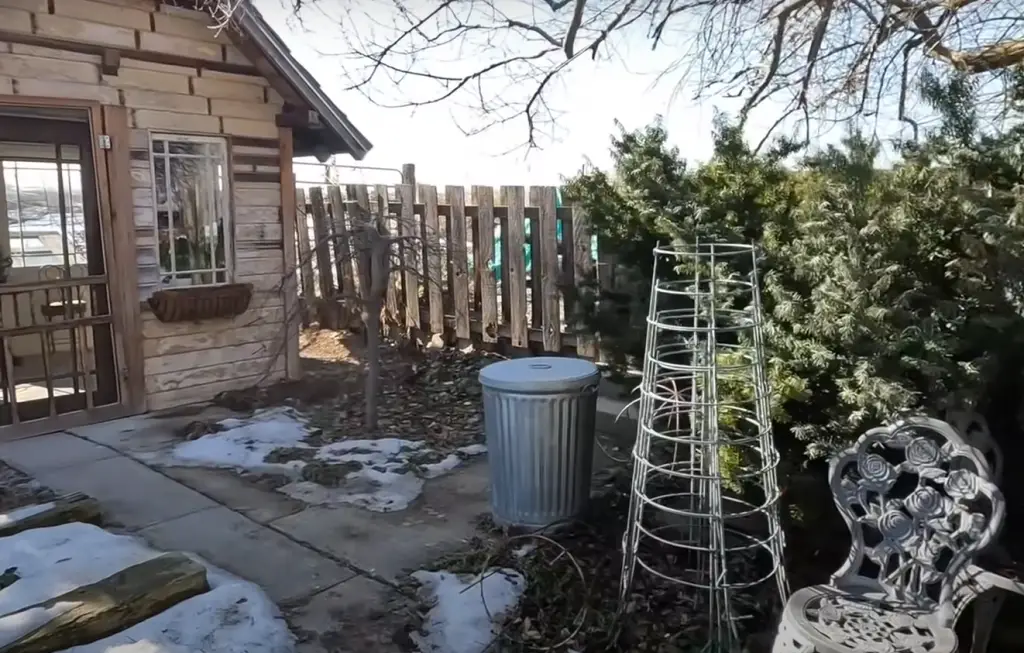
You can use them as an accent plant or create a dramatic border with several different lengths of grasses planted along the edge of your property line. Whatever look you choose, ornamental grasses will add texture and movement to your outdoor space as well as provide privacy between you and your neighbors!
Rock Wall Garden
A rock wall garden is an excellent property line landscaping idea. Not only does it provide a unique barrier between your home and the neighbor, it also looks great! You can design a creative rock wall with different textures and shapes to create an eye-catching landscape feature. Additionally, you can use this as an opportunity to get creative with plantings in front of the wall such as groundcover, succulents and other small plants. This will add color and texture to your garden. Be sure to consult with a professional before beginning any major construction project like this so that you’re aware of any potential land restrictions or regulations that could be applicable in your area. With careful planning and creativity, you’ll be able to create a stunning rock wall garden that adds beauty and value to your home.
Use Trellises
Trellises are an excellent way to add vertical interest to your property line landscaping.
Choose timber or metal trellis designs based on the look you want to achieve and make sure they’re strong enough to support any plantings you plan to attach them with. Make sure the trellis is placed properly so it won’t interfere with the view from either side of your property line.Plants for Property Lines
The next step in your property line landscaping project is to decide what kind of plants you should add. There are many different types of plants that can be used to create a beautiful landscape for your property lines. Some of the most popular options include:
- Native shrubs and trees – Planting native shrubs and trees along the property line allows you to create a natural look while maintaining privacy at the same time. Native species tend to be hardier, require less maintenance, and generally provide more habitat value than non-native varieties.
- Perennial flowers – Perennials provide bright pops of color throughout the growing seasons. Choose varieties that grow quickly and bloom early so they don’t get overshadowed by other plants.
- Ornamental grasses – Ornamental grasses are great for adding texture and movement to your property line landscaping. They also require little maintenance and can offer a variety of benefits, including reducing noise pollution and providing food for wildlife. [3]

No matter what kind of plants you choose, it’s important to remember that they all need plenty of sunlight and water in order to thrive. Make sure you research the specific needs of the plants before planting them along your property line in order to get the most out of your landscaping project.
FAQ
How close to the property line can I plant a hedge?
The exact distance that you can plant a hedge near the property line will depend on your local regulations and landscape codes. Generally, it’s best to keep shrubs and hedges at least 3 feet away from the boundary line to avoid any potential disputes with your neighbor. Be sure to check with your local authorities before planting anything close to your property line. [4]
How do I design landscaping around my house?
When planning landscaping around your house, the most important thing to consider is the property line. The property line marks the boundary of your home and determines what can and cannot be included in your landscaping design.
The good news is that there are plenty of options when it comes to landscaping along a property line. You can create an attractive border of shrubs or trees, or even install a fence for privacy. Additionally, you can add gravel pathways, decorative boulders, or flower beds for added color and texture.
No matter what type of landscape design you choose, it’s important to remember that the area near your property line should remain open and visible so that your neighbors can see where the boundary is. You can use low-growing shrubs or plants, as well as gardens that are raised above ground level to give your landscaping a more interesting look without blocking the view of your property line.
When it comes to maintaining your landscaping around the house, make sure that you keep any trees or shrubs trimmed so they don’t overgrow and encroach on the neighboring property. Additionally, be mindful of how much sunlight and water each area gets so that you can keep everything healthy and looking its best.
Finally, don’t forget to take into consideration local zoning laws and ordinances; this will ensure that you follow all applicable regulations for residential properties in your area.
What can I plant next to my neighbors fence?
Different plants thrive in different climates and soil conditions, so the best option for your neighbors’ fence will depend on where you live.
Shrubs are popular choices for lining property boundaries because they don’t take up much space and can provide privacy if planted close together. Some good shrub options include boxwood, holly, and viburnum, which all have evergreen foliage that can help keep your yard looking neat and tidy year-round. If you’re looking for something more colorful or fragrant, consider flowering varieties like azaleas or rhododendrons.
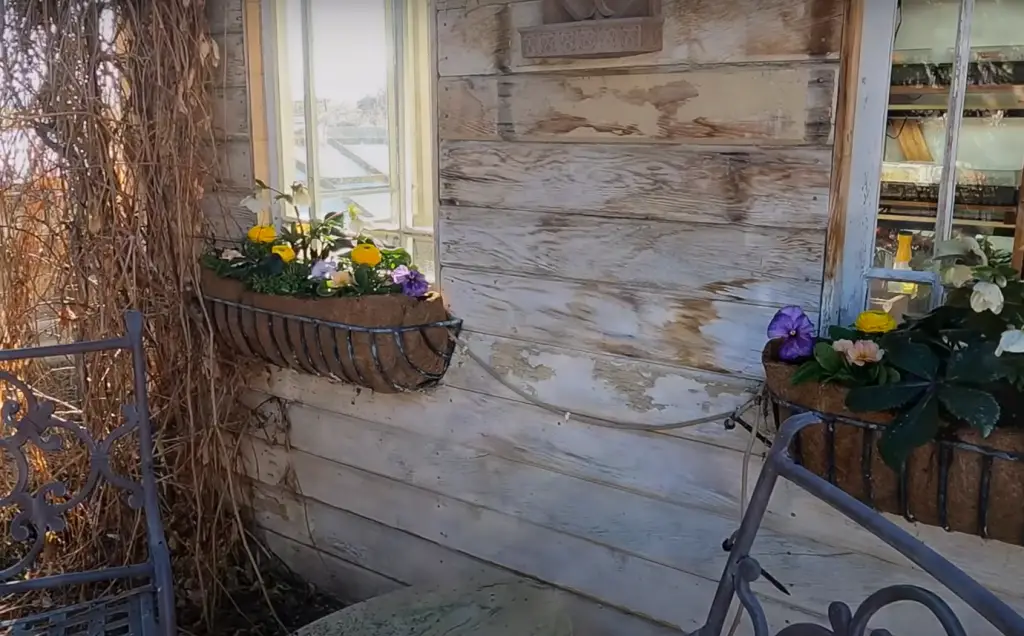
Trees are also great options for property line landscaping. While they take up more space than shrubs, they can provide shade, privacy, and a beautiful focal point in your yard. Popular choices include flowering varieties like cherry or dogwood trees, as well as evergreens such as spruce or fir trees.
Grasses are another excellent choice for property line landscaping. Depending on what type of grass you choose, it can add texture and color to your yard while taking up minimal space. Ornamental grasses such as fountain grass and Japanese pampas grass work particularly well for boundaries because they stay low-growing and don’t require much maintenance.
Finally, ground covers are an ideal option if you want a low-maintenance landscape near your property line. Many species of creeping phlox and evergreen sedum are good choices for this purpose, as they require minimal care and can help keep weeds at bay. [5]
When it comes to landscaping near a property line, there is no one-size-fits-all answer. The best option for you will depend on the climate and soil conditions, as well as the amount of space and maintenance you’re willing to devote to the project. Consider shrubs, trees, grasses, and ground covers for the perfect property line landscaping solution.
What is the fastest growing plant for privacy?
The fastest growing plant for privacy is bamboo. It’s a fast-growing, hardy plant that will look great in your landscaping and provide you with the privacy you need. Bamboo can grow up to 3 feet per year and, depending on the variety you choose, it can reach heights of 40 feet or more! Plus, it’s low maintenance and doesn’t require much pruning. If you want to establish a dense screen quickly and easily, bamboo is an excellent choice.[6]
When selecting bamboo plants for your property line landscaping, be sure to choose clumping varieties instead of running varieties. Running varieties tend to spread aggressively by underground runners so they might invade neighboring properties if not regularly monitored.
If you’re not a fan of bamboo, are plenty of other fast-growing plants that will provide you with the same level of privacy: Evergreen trees and shrubs like Leyland Cypress, Thuja Green Giant, arborvitae, or boxwood are all excellent choices. Or maybe try a flowering vine such as Wisteria or Clematis for some extra color in your garden! Whatever type of plant you choose for privacy screening on your property line, make sure it fits well into your overall landscaping plan.
Useful Video: Creating a Natural Edge on My Shared Property Line
Conclusion
Property line landscaping is a great way to add beauty, privacy, and value to your home. With careful planning, you can make sure that the landscaping you do is not only functional but aesthetically pleasing as well. When designing your property line landscaping, be sure to consider all of the options available so that you can find the perfect solution for your needs. You should also take into account any local regulations or ordinances before starting any major construction project on your property lines. Finally, remember that a little bit of effort now could pay off in big ways when it comes time to enjoy your improved outdoor space!
Hopefully this guide has helped you feel more informed about property line landscaping and given you some useful tips for creating an attractive functional landscaping design that you can be proud of. Happy planting!
References:
- https://www.thespruce.com/ideas-for-landscaping-property-lines-2132169
- https://kellogggarden.com/blog/lawn-care/6-easy-ideas-for-landscaping-property-lines/
- https://www.finegardening.com/article/plants-for-property-lines
- https://lawncaregrandpa.com/property-line-bushes-how-close-to-the-line-can-they-be/
- https://pondinformer.com/plants-for-privacy/
- https://www.bobvila.com/articles/best-trees-for-privacy/









Leave a Reply
View Comments